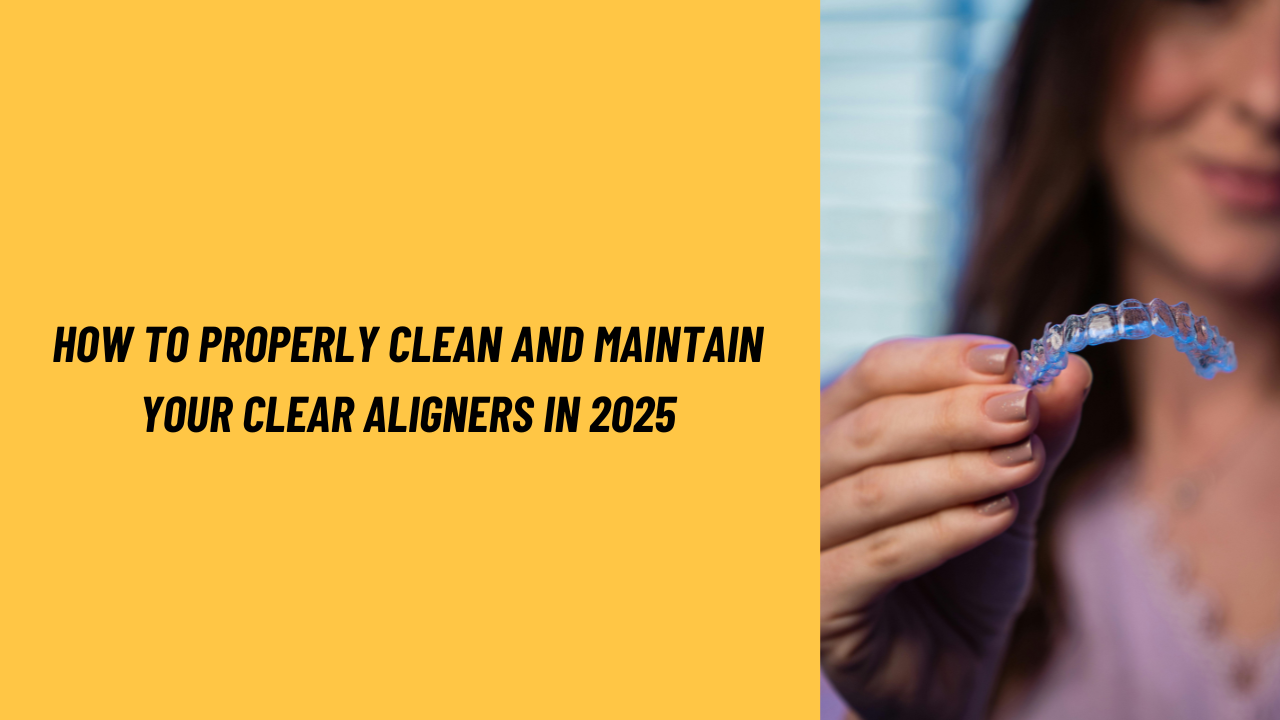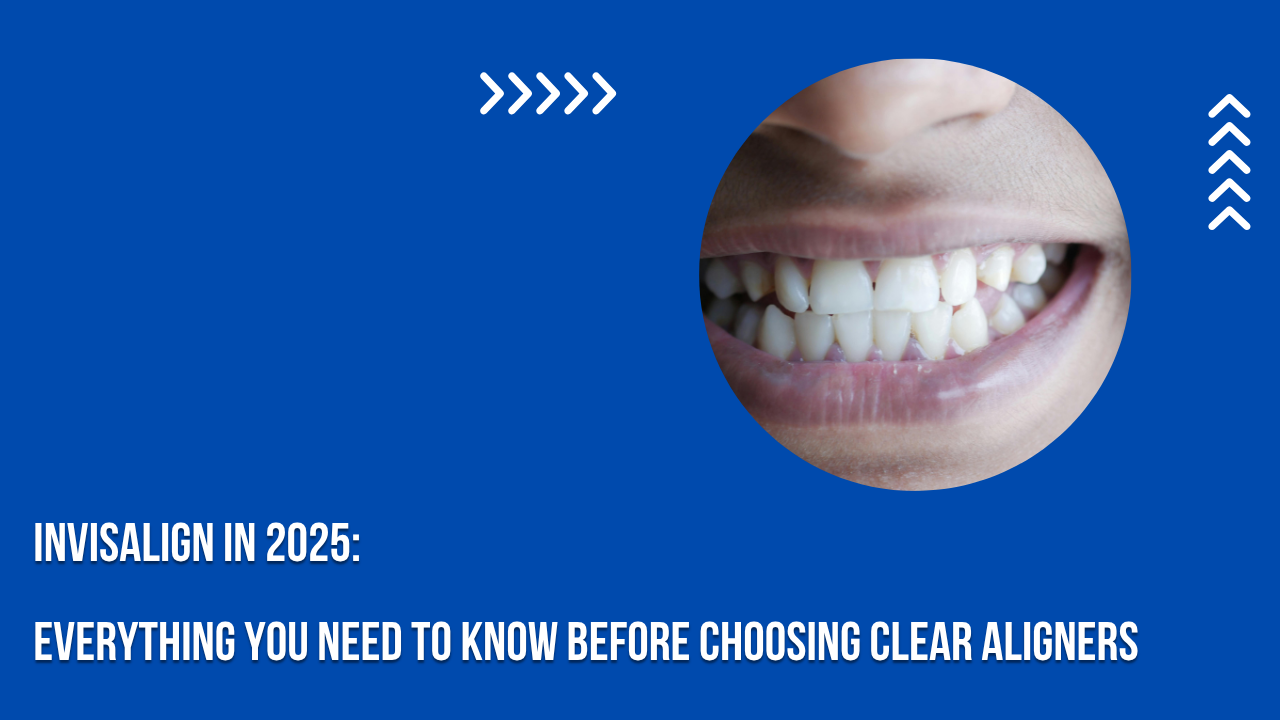Clear aligners have become the preferred choice for discreet and comfortable orthodontic treatment. Whether you’re addressing minor crowding or undergoing a complete smile transformation, these nearly invisible trays are designed to move your teeth accurately and flexibly. However, there is an important caveat: if you don’t maintain and clean them properly, they won’t function as intended.
This isn’t meant to alarm you—it’s simply a fact. The positive aspect? Taking care of aligners is straightforward once you know the essential do’s and don’ts. This guide presents the information clearly—without any unnecessary details or pressure—providing you with everything you need to keep your trays clean, fresh, and effective.
Why Aligner Hygiene Matters
Although aligners may appear to be merely “plastic trays,” they are worn in your mouth for most of the day, making them a component of your oral environment. If they aren’t kept clean, your smile won’t be either, which can result in:
– Bacterial buildup
– Persistent bad breath
– Stains on both your aligners and teeth
– Higher chances of cavities and gum irritation
– Treatment delays caused by improper fit or plaque accumulation
Therefore, cleaning your aligners shouldn’t be viewed as a chore; it’s simply a necessary part of the process. Once you incorporate it into your daily routine, it will become second nature.
Morning and Evening Routine: The Basics Done Right
Here’s a simple guide to keep your aligners clean without complicating your routine.
1. Rinse in the Morning
Each morning, take out your aligners and rinse them with lukewarm water. This removes the dry saliva that has built up overnight and prepares them for a deeper clean. It also helps prevent any unpleasant odors.
2. Gently Brush with Clear Soap
Avoid using toothpaste. Instead, use a soft-bristled toothbrush along with clear, unscented antibacterial soap. A light lather, a few seconds of gentle circular brushing, and a thorough rinse will effectively eliminate plaque without damaging the aligners.
Make sure to use a different toothbrush than the one you use for your teeth to prevent transferring any toothpaste residue or bacteria.
3. Clean Your Teeth as Well
Brushing your teeth is essential. If you put your aligners back on over teeth that still have food particles or sugars, you create a perfect environment for bacteria to grow, which can lead to cavities, stains, and gum irritation quickly.
A quick flossing session is also beneficial, especially if you tend to accumulate debris between your teeth.
Midday Tips: On-the-Go Doesn’t Mean Skipping Care
Let’s face it — many individuals eat while at work, school, or on the go, which can complicate things.
When you remove your aligners:
– Rinse them right away, even if brushing isn’t an option.
– Keep them in a clean, breathable case (avoid using a napkin).
– After eating, brush your teeth or at least rinse your mouth before reinserting them.
If you can’t brush, swish some water or use a gentle, sugar-free mouthwash. While it’s not ideal, it’s preferable to leaving food particles trapped under your aligners.
Deep Cleaning: The 2–3 Times a Week Ritual That Works
Despite regular rinsing and brushing, aligners can become dull over time, which is where deep cleaning becomes essential.
Performing a deep clean every few days helps to break down biofilm, remove stubborn residue, and maintain the invisibility of your aligners.
Here are some effective options:
- Invisalign Cleaning Crystals – Ideal for those seeking a quick and efficient solution specifically designed for aligners. Simply dissolve a packet in warm water, soak the trays for 15–30 minutes, rinse, and you’re finished.
- Hydrogen Peroxide Solution – Combine equal parts of 3% hydrogen peroxide and water. Soak for 20–30 minutes, then rinse thoroughly to eliminate any aftertaste.
- White Vinegar Soak – Mix 1 part vinegar with 3 parts water. This method is effective for removing calcium and tartar buildup, but limit it to once a week to prevent strong taste retention.
- Retainer Cleaning Tablets – Perfect for those with a busy lifestyle. Just drop a tablet into a cup of warm water, soak your aligners, rinse, and you’re good to go.
No matter which method you select, be sure to rinse and brush the trays after soaking to remove any remaining residue and taste.
Common Mistakes to Avoid
Here are some frequent errors we notice and reasons to steer clear of these habits:
Using toothpaste: Even gentle types can be abrasive, leading to micro-scratches that cause cloudiness and odor retention.
- Boiling or hot water: This can distort the plastic. If the shape changes, it may interfere with your treatment progress.
- Bleach or harsh chemicals: These substances are too potent. They can damage the plastic and irritate your gums.
- Mouthwash (especially colored varieties): Many mouthwashes contain alcohol or artificial dyes, which can stain or weaken your trays.
If your cleaner has a scent reminiscent of your kitchen or bathroom, it’s likely not suitable for something you place in your mouth.
Proper Storage of Your Aligners: A Hygiene Practice Often Ignored
You may be following all the right steps while wearing your aligners, but what about when they’re not in your mouth?
Avoid leaving your aligners exposed. Once they are in contact with air, they can attract dust and bacteria. Wrapping them in a napkin is a common way people accidentally throw them away.
Instead, adhere to these guidelines:
- Always keep your aligner case with you.
- Clean the case weekly with warm water and soap.
- Avoid airtight containers unless they are specifically designed for aligners (they require ventilation).
- Do not leave them in direct sunlight or hot areas, as they can warp even when not in use.
A clean case plus clean aligners equals no issues.
Eating and Drinking Guidelines: What You Can (and Shouldn’t) Do
Aligners require some discipline when it comes to food and drinks.
Safe to Consume While Wearing:
- Water — at room temperature or cool
- Nothing else. Seriously.
What to Avoid With Aligners In:
- Coffee or tea — can cause stains and warping
- Soda or fruit juices — sugars and acids can lead to decay
- Alcohol — dries out your mouth and damages the plastic
- Chewing gum — can stick to the trays
- Hot drinks — can quickly deform the trays
Always take out your aligners when eating or drinking anything other than water. Afterward, clean your mouth, rinse your trays, and put them back in.
Consequences of Neglecting Cleaning (And Why It Becomes Apparent Quickly)
You may not notice it immediately, but dirty aligners can catch up with you fast. It starts with a faint odor, followed by slight cloudiness. Soon, your teeth may appear dull, and your breath? Not pleasant.
Even worse, you could face:
- Tartar and plaque buildup inside the trays
- White spots on your enamel (early signs of decay)
- Mouth ulcers or irritation from bacteria
- Extended treatment time if trays no longer fit properly
The clearer your aligners are, the more discreet your treatment feels — and the better you stay on track.
Quick Maintenance Tracker (for Consistency)
| Task | How Often |
| Rinse aligners with water | Every removal |
| Brush aligners with soap | Twice daily |
| Deep soak in cleaning solution | 2–3x per week |
| Clean aligner case | Weekly |
| Brush & floss teeth | After every meal |
| Avoid colored drinks with trays | Always |
Cleaning Your Clear Aligners: Just a Few Minutes Each Day
It might seem like taking care of your aligners is an added chore, but the reality is that clear aligners are designed for ease. No wires, no brackets, and no emergencies—just a clean mouth, transparent trays, and progress.
If you can spare 5 minutes in the morning and another 5 at night to clean your trays and brush your teeth, you’ll ensure a smoother, more comfortable treatment and improve your overall oral health.
Stay Consistent and Keep Them Clear.
The demand for invisible orthodontic solutions is increasing, with clear aligners at the forefront. However, keep in mind that while they are invisible, they are not indestructible. They are effective tools, but only when properly maintained.
By incorporating cleaning into your daily routine rather than treating it as an afterthought, you’re not just safeguarding your trays; you’re also protecting your smile.
So, the next time you remove your aligners for a meal, take a moment to rinse them, store them correctly, and continue with your care routine. It’s that easy, and your future self—boasting a confident, straight smile—will appreciate it.




